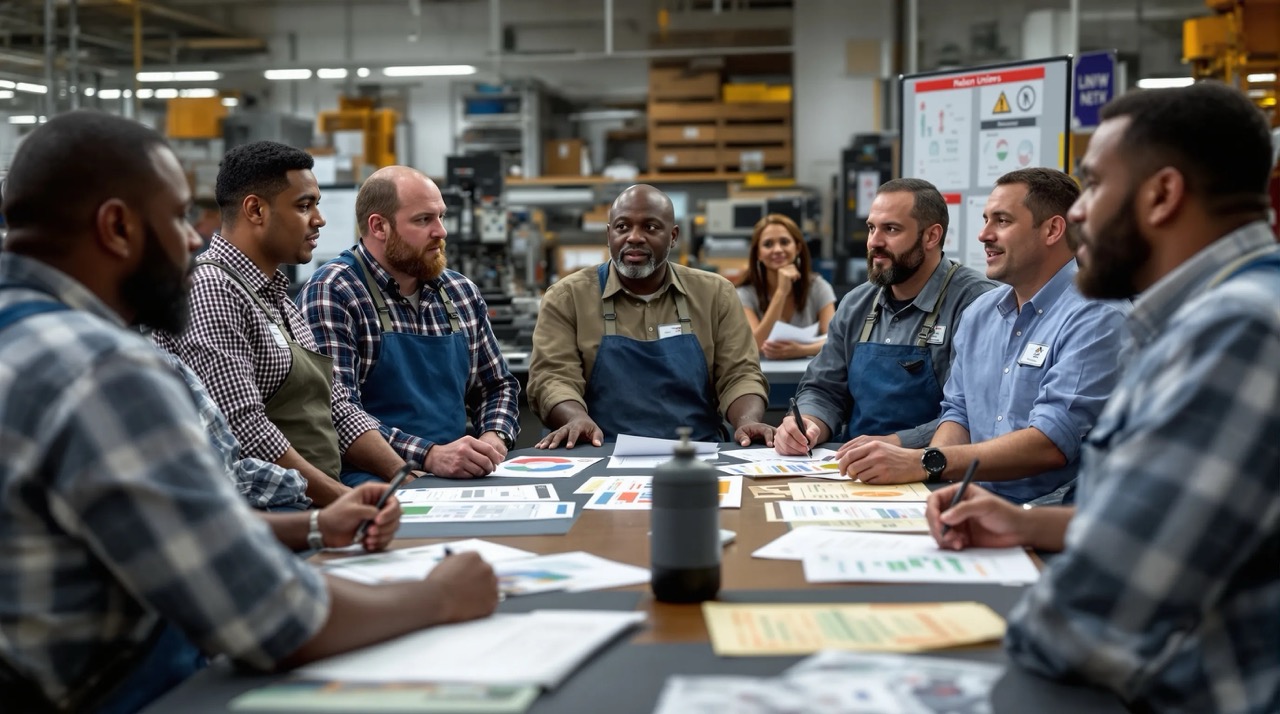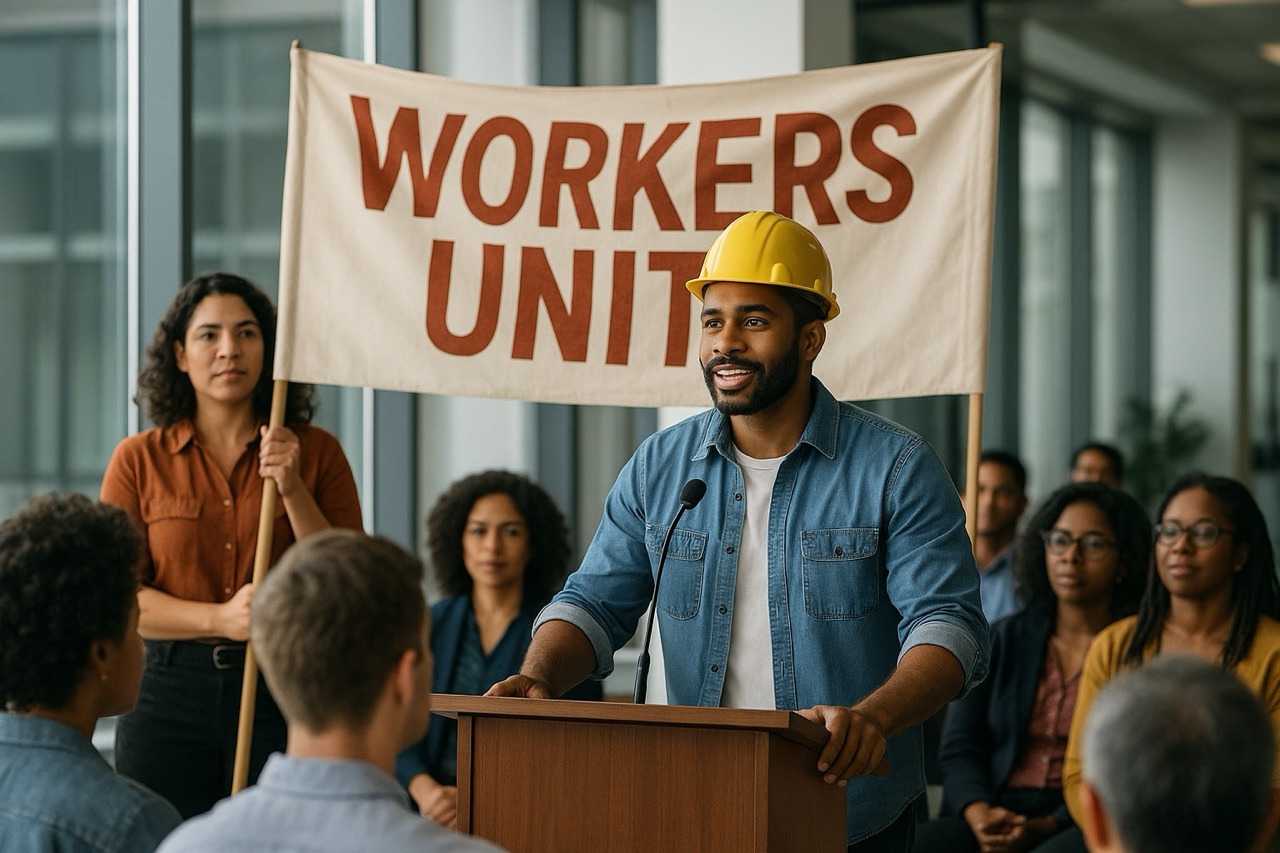

Content
Table of Contents
Think about the problems that keep coming up at work: schedules that change at the last minute, pay that doesn’t stretch far enough, and safety issues nobody fixes. You might bring it up, others might complain too, but nothing really changes. That’s a common story, and it leaves many people feeling stuck.
But when workers start talking to each other and realize they’re dealing with the same things, the picture shifts. Acting together gives people leverage they just don’t have on their own. That’s what a union is about.
Surveys show close to 60 million workers would join a union if they could, but only a small share actually belong to one. The interest is there, what’s often missing is guidance on how to start a union and how the process works.
Forming a union isn’t quick, but it’s possible. It usually takes several months to a year or more, moving from quiet conversations with coworkers to sitting down at the table for a first contract. These days, workers use a mix of traditional tactics (face-to-face talks, meetings, and petitions) along with digital tools that help them coordinate and keep track of support. Step by step, that’s how frustration turns into bargaining power.
Understanding your rights to unionize
Most private-sector workers in the U.S. have the legal right to form a union. This has been true since 1935, when the National Labor Relations Act was passed. What that means in practice is simple:
You can talk with coworkers about wages, schedules, benefits, or safety.
You can hand out union flyers or materials during breaks or in non-work areas.
You can wear buttons, pins, or union shirts on the job, unless there’s a genuine safety reason not to.
You can attend union meetings outside of work.
Your boss isn’t supposed to punish you for any of this. If they fire, threaten, or demote you because of union activity, that’s illegal retaliation. When that happens, you can take the case to the National Labor Relations Board (NLRB). If the board rules in your favor, they can order your job back and award back pay.
But here’s the reality: the NLRB is stretched thin. They’re handling close to 25,000 cases a year with about half the staff they had twenty years ago. Cases move slowly. That’s why it helps to keep records (dates, times, witnesses) so if something happens, your complaint is as strong as it can be.
These rights apply to most workers, even part-time and temporary employees. The main exceptions are supervisors, managers, and independent contractors. Public-sector workers also have organizing rights, but the rules depend on the state you’re in.
Identifying workplace issues that drive organizing
Organizing usually starts when people realize they’re all dealing with the same problems. Maybe you’ve noticed your pay hasn’t gone up in years. Or every schedule feels like a guessing game. Or safety complaints just sit there, ignored. One person bringing it up might not make much of a difference. But when everybody’s fed up with the same things, that’s when people start thinking about acting together.
Some of the issues that push workers to organize again and again are pretty familiar:
Pay that doesn’t cover the basics, health insurance that costs too much, or seeing someone else make more for the same job.
Schedules that change at the last minute, forced overtime, and not enough people on shift.
Missing gear or unsafe conditions that management shrugs off.
Getting disciplined for no reason, watching favorites get promoted, and never having a real say in decisions.
If you’re trying to build support, start with the problems everyone feels. Those are the ones that can bring people together. They’re also the kinds of issues you can actually fix in a contract — like getting clear rules for promotions or guaranteed hours instead of endless uncertainty.

Building support through one-on-one conversations
Every union organizing effort starts small, usually with quiet talks between people who already trust each other. These conversations are how you find out if your coworkers feel the same frustrations you do and whether they’re open to doing something about it together.
The best time for these talks is when you’re away from management’s ears: on breaks, at lunch, after work. And the key is to listen more than you talk. Ask simple questions: “How are you feeling about the schedule?” or “Do you think things could be better if we pushed together?”
Interest in unions is rising fast. Union election petitions have more than doubled since 2021, reaching the highest level in over a decade. You’re not alone in wanting change.
A few things that make these conversations effective:
Start with the problems people already feel, not with “we need a union.”
Listen for issues that affect more than one person.
Don’t push for a yes or no on the spot, just see if they’re open.
Notice who shows real interest; these are often the people who step up later as leaders.
Keep in mind: employers sometimes watch for organizing. If you’re tracking who’s supportive, keep that information safe and private. Notes, lists, conversations: handle them carefully. This is a key part of how to start a union, since protecting workers’ privacy ensures the effort can move forward safely.
Forming an organizing committee
Every campaign needs a core group of people who keep things going. That’s what the organizing committee is: a handful of trusted coworkers who take responsibility for talking to others, sharing information, and making decisions together.
It shouldn’t just be the same few people who always hang out. A good committee includes folks from different departments, shifts, and backgrounds. That way, no part of the workplace feels left out, and management can’t claim it’s just one group stirring things up.
The committee’s work is pretty practical:
Figuring out who works where and what issues matter most to them.
Having one-on-one conversations to see who’s on board.
Pulling people together for meetings or actions when it’s time.
Keeping in touch with everyone so the effort doesn’t stall.
In bigger workplaces, this usually means 8-15 people, spread across departments, so there’s coverage everywhere. They’ll meet regularly, away from work, in a private location to compare notes and plan the next steps.
And once a union is won, the committee doesn’t just disappear. Most of the time, they stick around to help negotiate the first contract and keep coworkers engaged for the long run.
Choosing between joining an established union or going independent
Workers have two main options for union formation: affiliating with an established labor organization or creating an independent union. Each approach offers different advantages depending on workplace size, industry, and organizational goals.
Established unions provide professional organizers, legal expertise, existing contract templates, and strike funds. They offer experienced negotiators for first contract talks and political advocacy power. Most established unions cover organizing costs and provide ongoing support throughout the campaign.
Independent unions offer complete local control over decisions, faster decision-making processes, and no dues payments to national organizations. They allow customized structures that fit specific workplace needs without conflicts with national union policies.
To join an established union, research organizations that represent workers in your industry. Contact their organizing departments to discuss your workplace situation and available support. Most unions assign professional organizers and provide campaign resources at no cost during organizing.
Independent unions work well for smaller workplaces or situations where established unions don't match your specific needs. However, independent organizing requires more work from your committee since you handle all legal, financial, and strategic aspects without external support.

Collecting authorization cards and filing with the NLRB
At a certain point, organizing moves from conversations to paperwork. That paperwork is the authorization card, a legal document where a worker signs to show they want union representation. When enough people have signed cards, you can ask the National Labor Relations Board (NLRB) to hold a union election.
What’s on the card is simple: your name, job title, address, and signature, plus a statement that you want the union to represent you. Cards stay valid for a year, and if someone changes their mind, they can withdraw by writing to the NLRB.
By law, at least 30% of the workforce needs to sign before the NLRB will even consider an election. But most campaigns don’t stop there. They push for 60–70% support before filing, because going public without a solid majority makes it much easier for management to divide people or stall the process.
Cards are collected through one-on-one talks, usually led by members of the organizing committee. The focus isn’t on paperwork first; it’s on connecting the union effort to the issues that matter most: pay, schedules, safety, or fairness. Signing the card becomes a step toward fixing those problems together.
You can also collect cards digitally, which can be done via Solidarity Tech, making it easier for workers to participate even if they can’t attend in-person meetings.
Security is critical. Keep cards and records in safe places, never at the worksite, and never let management know who signed. Protecting supporters’ privacy is part of preserving the campaign.
Once you’ve built enough support, you file a petition with your local NLRB office. If the Board finds you meet the requirements, it will set a date for an election.
It’s worth knowing that the process doesn’t end with winning a vote. Negotiating a first contract takes time, now averaging more than a year. Research on thousands of campaigns shows that many unions don’t reach a first agreement within the first 12 months. That’s why building strong support early matters: it helps keep momentum alive through the long stretch of bargaining that follows.
Winning the union election
Once the NLRB sets the date, you usually have a few weeks before the vote. At that time, both sides talk to the workers. Management will likely hold meetings, send out messages, and maybe even make promises. They’re trying to convince people not to vote yes.
Union supporters use that same time to remind coworkers why the campaign started in the first place: low pay, messy schedules, and safety concerns. The committee spends a lot of those weeks checking in one-on-one, answering questions, and making sure people feel confident about voting.
The vote itself is simple. It’s a secret ballot, run by the NLRB, usually at the workplace during work hours. Everyone in the unit can vote, regardless of whether they signed a card. Both the employer and the union can have observers there, but it’s the NLRB staff who actually run it.
If more than half of the people who vote choose the union, the NLRB certifies it as the bargaining representative. That gives the union the legal right to negotiate over wages, benefits, and working conditions.
If the vote doesn’t go through, you have to wait a year before filing again. But a loss isn’t the end. Many groups come back stronger after the first try, once they’ve had time to deal with whatever held people back.
Negotiating your first contract
Winning the vote feels huge, and it is. But the hard work isn’t over. The next step is sitting down to hammer out your first contract. That’s where the union puts everything on paper: pay, benefits, scheduling, safety rules, job protections.
It doesn’t happen overnight. Usually talks start a month or two after certification, and they can drag on for months. Sometimes close to a year, sometimes longer. That can feel slow, but it’s normal. Management often hopes people lose steam, which is why keeping folks engaged matters.
The bargaining team is usually made up of the same people who helped organize, now joined by union reps with experience at the table. Together, they pull proposals from the issues that pushed everyone to manage in the first place: wages that cover the bills, fair schedules, and protection from unfair discipline.
Most first contracts deal with the basics:
pay rates and raises
health insurance, retirement, time off
rules around discipline and layoffs
safety and working conditions
union rights, like access and dues
Bargaining happens across a series of meetings. Sometimes weekly, sometimes less often. Sessions can last hours, with back-and-forth over every line of language. If things stall, a federal mediator can step in at no cost.
And here’s the part to remember: nothing is final until workers vote on it. The committee can bargain and reach a tentative deal, but it only becomes real if the members say yes. This is an important step for anyone learning how to start a union, understanding that workers always have the final say.
How Solidarity Tech helps union organizing campaigns
Today's organizing campaigns still run on face-to-face conversations, but they're now backed by digital tools that help organizers track outreach efforts and securely manage sensitive campaign information. Solidarity Tech provides organizing platforms designed specifically for labor campaigns.
Secure member data management protects sensitive organizing information during campaigns when employer surveillance poses real risks. The platform encrypts all stored data and communications, making it difficult for employers to access information about which workers support organizing efforts. Access controls ensure only authorized organizers can view confidential campaign data, like authorization card tracking or supporter assessment scores.
Integrated communication tools help organizing committees coordinate outreach across different shifts and departments. Multi-channel communication through email, SMS, and phone calls gets logged automatically to member profiles, creating complete interaction histories. The predictive dialer maximizes volunteer calling time during authorization card drives or pre-election outreach by connecting organizers only when supporters answer their phones.
Instead of you manually managing texts, emails, and sign-up sheets, the platform keeps all your event details organized in one place. It can handle RSVPs, send reminders, and track who showed up, whether it’s a quick meeting, a solidarity action, or a contract vote. Everything ties into a shared calendar, so people know what’s coming, in person or online. That way, the committee spends less time chasing details and more time keeping people involved through a long campaign.
Workplace mapping capabilities use the Wall Chart feature to visualize membership by department, shift, or other workplace attributes. Custom fields track organizing activities like authorization card signatures and worker support levels, helping committees assess the degree of backing from each worker. This enables them to identify areas needing additional attention and measure campaign progress systematically.
Having everything in one secure place means your committee spends less time managing spreadsheets and more time talking with coworkers, especially crucial in the high-pressure weeks before an election.
Frequently asked questions about starting a union
How many employees do you need to start a union?
There’s no minimum number set by law. What matters is the majority support. Even a very small workplace can organize, but you’ll need more than half of the workers on board to win. In practice, it’s easier if you’ve got at least a few people, say 3–5, who can stick together and build support.
Can you start a union in a workplace with fewer than 10 employees?
Yes. Small workplaces have the same legal protections as larger ones. The challenge is numbers: in a group of 8 workers, losing the support of just one or two people can block you from reaching a majority. Still, plenty of small shops have organized successfully when everyone shared the same concerns.
How long does it usually take?
It’s not instant. From the first conversations to a signed first contract, it often takes 6–18 months. Roughly:
A few months to build majority support,
A few weeks for the NLRB election,
Then another 6-12 months of bargaining to get a first contract.
Can you get fired for trying to start a union?
Legally, no. It’s against federal law for your employer to fire, threaten, or punish you for union activity. If it happens, the NLRB can order your job back with back pay. That said, retaliation does happen, which is why it’s important to keep good records (dates, times, witnesses) and to file charges quickly if needed.
What if the union vote doesn’t pass?
If the union loses the election, you have to wait a year before filing again in the same unit. That time doesn’t have to go to waste. Many campaigns use it to strengthen their committee, address concerns that came up, and come back better prepared, and a lot of them win the second time around.
read more
Explore More Union Organizing Resources
From forming a union to using modern organizing software, discover how workers build lasting strength together




